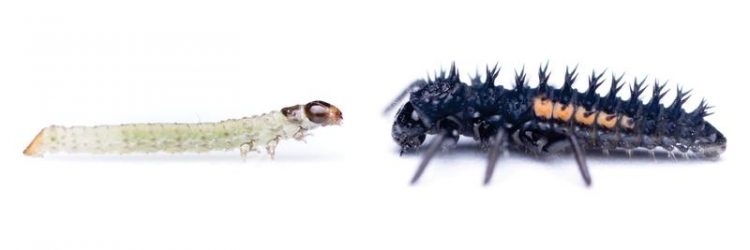Whether horseradish flea beetles can deter predators depends on their food plant and their life stage

The larva of the horseradish flea beetle Phyllotreta armoraciae (left) is well-armed against its enemy, the larva of the harlequin ladybird Harmonia axyridis (right). Benjamin Fabian / Max Planck Institute for Chemical Ecology
A research team at the Max Planck Institute for Chemical Ecology in Jena, Germany, has now found that these glucosinolates are present in all life stages of the horseradish flea beetle; however, the enzyme required to convert these into toxic substances is not always active.
Although larvae are able to successfully fend off attack from a predator, such as the harlequin ladybird, pupae are predated because they lack enzyme activity (Functional Ecology, February 2020, doi: 10.1111/1365-2435.13548).
As their name suggests, horseradish flea beetles feed on horseradish, but also on other plants that are equipped with a so-called “mustard oil bomb”, such as rapeseed, mustard and other cruciferous plants. This defensive mechanism is based on two components: glucosinolates (or mustard oil glucosides) – plant defense compounds – and the enzyme myrosinase. When the plant tissue is damaged, the non-toxic glucosinolates come into contact with the myrosinase, which converts the glucosinolates into toxic mustard oils, so the “bomb is triggered”.
The horseradish flea beetle copies the plant defense system by taking up non-toxic glucosinolates from its food plants, and producing its own beetle myrosinase (see our press release on the closely related striped flea beetles „Beetles that taste like mustard”, May 8, 2014).
A team of scientists led by Franziska Beran, head of the Research Group “Sequestration and Detoxification in Insects” at the Max Planck Institute for Chemical Ecology in Jena, Germany, now wanted to find out whether all developmental stages, from egg to beetle, can defend themselves with their mustard oil bomb and whether it represents an effective protection against predators.
Their experiments revealed that glucosinolates can be found in all life stages of the horseradish flea beetle. However, the beetle myrosinase was not active in all of them. The researchers determined myrosinase activity by measuring the sugars, which are cleaved off the glucosinolates by the myrosinase enzyme. These sugars accumulate over time.
„Larvae showed a high level of enzyme activity, whereas the activity could hardly be detected in pupae. The ability to fend off predators by using plant defense substances therefore differs considerably between the different life stages“, Theresa Sporer, the first author of the study, describes the results.
To find our whether the differences in enzyme activity are really important for an efficient defense, the scientists offered the larvae and pupae of the horseradish flea beetle to a voracious predator, the larvae of the harlequin ladybird. “What we observed in this experiment was impressive”, Johannes Körnig, a co-author of the study, reports. “When a lady beetle larva attacks a flea beetle larva, it feeds only very briefly, then moves away from their prey and frequently vomits.
They rather starve to death than feed on larvae which are protected by a mustard oil bomb.” In contrast, pupae had no chemical protection and were eaten by ladybird larvae. Likewise, a comparison of larvae which had either stored glucosinolates or not, depending on which plant they fed beforehand, showed that these plant chemical compounds are in fact crucial for defense: Larvae that had stored glucosinolates were able to fend off predators, whereas larvae without glucosinolates were killed.
For the researchers, it was still surprising that pupae were not chemically protected. After all, during this developmental stage they are immobile and cannot escape. Therefore, one would expect that a particularly good chemical defense would compensate for the immobility of pupae. However, it is still unclear which predators feed on pupae. The scientists hypothesize that nematodes and microbial pathogens could be important natural enemies.
Further studies are planned to find out whether the beetle’s mustard oil bomb can also be successfully used against enemies in the natural habitat of the horseradish flea beetle. Moreover, they would like to investigate which substances are important for the pupae’s defense against their natural enemies and whether pupae deploy other defense mechanisms. The results will also be of interest for gardeners, since horseradish flea beetles are suspected to be responsible for the drop of yield in horseradish cultivation.
Contact and Picture Requests:
Angela Overmeyer M.A., Max Planck Institute for Chemical Ecology, Hans-Knöll-Str. 8, 07743 Jena, Germany, Tel. +49 3641 57-2110, E-Mail overmeyer@ice.mpg.de
Dr. Franziska Beran, Max Planck Institute for Chemical Ecology, Hans-Knöll-Straße 8, 07745 Jena. Tel. +49 3641 57-1553, E-Mail fberan@ice.mpg.de
Sporer, T., Körnig, J., Beran, F. (2020). Ontogenetic differences in the chemical defence of flea beetles influence their predation risk. Functional Ecology, doi: 10.1111/1365-2435.13548 (accepted article)
https://doi.org/10.1111/1365-2435.13548
https://www.ice.mpg.de/ext/index.php?id=detoxification&L=0 Homepage of the Research Group Sequestration and Detoxification in Insects
http://www.ice.mpg.de/ext/downloads2020.html Download of videos and high-resolution images
Media Contact
All latest news from the category: Life Sciences and Chemistry
Articles and reports from the Life Sciences and chemistry area deal with applied and basic research into modern biology, chemistry and human medicine.
Valuable information can be found on a range of life sciences fields including bacteriology, biochemistry, bionics, bioinformatics, biophysics, biotechnology, genetics, geobotany, human biology, marine biology, microbiology, molecular biology, cellular biology, zoology, bioinorganic chemistry, microchemistry and environmental chemistry.
Newest articles

Properties of new materials for microchips
… can now be measured well. Reseachers of Delft University of Technology demonstrated measuring performance properties of ultrathin silicon membranes. Making ever smaller and more powerful chips requires new ultrathin…

Floating solar’s potential
… to support sustainable development by addressing climate, water, and energy goals holistically. A new study published this week in Nature Energy raises the potential for floating solar photovoltaics (FPV)…

Skyrmions move at record speeds
… a step towards the computing of the future. An international research team led by scientists from the CNRS1 has discovered that the magnetic nanobubbles2 known as skyrmions can be…





















